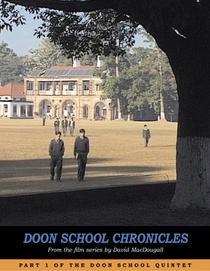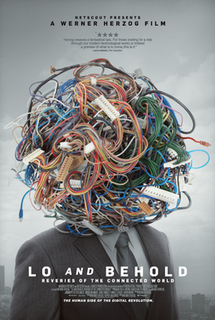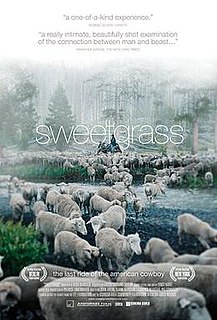 W
WLes Accords de Bella is a 2007 anthropological documentary film directed by David Constantin. It was selected by the African Film Festival of Cordoba - FCAT.
 W
WThe Anthropologist is a 2015 American documentary film directed by Seth Kramer, Daniel A. Miller, and Jeremy Newberger of Ironbound Films. The film follows environmental anthropologist Susie Crate and her teenage daughter Katie as they visit indigenous communities threatened by climate change. Featuring commentary from Mary Catherine Bateson, daughter of famed anthropologist Margaret Mead, the film explores how human beings adapt to catastrophic change.
 W
WApe and Super-Ape is a 1972 Dutch documentary film directed by Bert Haanstra. It was nominated for an Academy Award for Best Documentary Feature.
 W
WThe Ax Fight (1975) is an ethnographic film by anthropologist and filmmaker Tim Asch and anthropologist Napoleon Chagnon about a conflict in a Yanomami village called Mishimishimabowei-teri, in southern Venezuela. It is best known as an iconic and idiosyncratic ethnographic film about the Yanomamo and is frequently shown in classroom settings.
 W
WBitter Honey is a 2014 documentary film directed by anthropologist and filmmaker Robert Lemelson that chronicles the lives of three polygamous families living in Bali, Indonesia. The film follows the wives from their introduction to the polygamous lifestyle to the emotional hardships and jealousies to their struggle for empowerment and equal rights.
 W
WLaura Boulton was an American ethnomusicologist. She is known for the many field recordings, films and photographs of traditional music and its performances and practitioners from Egypt, the Sudan, Uganda, Kenya and Tanganyika. Boulton also collected traditional musical instruments around the world. In her work with the National Film Board of Canada (NFB) during the Second World War, she is recognized as being a pioneer for women who work in the film industry.
 W
WDead Birds is a 1963 American documentary film by Robert Gardner (1925-2014) about the ritual warfare cycle of the Dugum Dani people who live in the Baliem Valley in present-day Irian Jaya province on the western half of the island of New Guinea that is part of present-day Indonesia. The film presents footage of battles between the Willihiman-Wallalua clan and the Wittaia clan with scenes of the funeral of a small boy killed by a raiding party, the women's work that goes on while battles continue, and the wait for enemy to appear. In 1964 the film received the Grand Prize "Marzocco d'Oro" at the 5th Festival dei Populi rassegna internazionale del film etnografico e sociologico in Florence, Italy, the Robert J. Flaherty Award given by the City College of New York, and was a featured film at the Melbourne Film Festival. In 1998, Dead Birds was included in the annual selection of 25 motion pictures added to the National Film Registry of the Library of Congress. being deemed "culturally, historically, or aesthetically significant" and recommended for preservation. Dead Birds has come to hold canonical status among ethnographic films.
 W
WThe Doon School Quintet is a five-part ethnographic film series made by the American visual anthropologist and documentary filmmaker David MacDougall, between 1997 and 2000, at The Doon School, an all-boys boarding school in India. For thirteen months over three years, MacDougall lived with the students and was given unprecedented access for filming inside the residential campus. By the end, MacDougall had more than 85 hours of material, which he edited into 5 parts, with a total duration of about 8 hours. The project ranks among MacDougall's most ambitious and longest works and is the only film series in his oeuvre.
 W
WGrass: A Nation's Battle for Life (1925) is a documentary film which follows a branch of the Bakhtiari tribe of Lurs in Persia as they and their herds make their seasonal journey to better pastures. It is considered one of the earliest ethnographic documentary films. In 1997, Grass was selected for preservation in the United States National Film Registry by the Library of Congress as being "culturally, historically, or aesthetically significant".
 W
WHappy People: A Year in the Taiga is a 2010 documentary film directed by Dmitry Vasyukov, with English narration written and voiced by Werner Herzog. The film depicts the life of the people in the isolated village of Bakhta at the confluence of the Yenisei and the Bakhta River, in the eastern Siberian taiga. In particular, it focuses on the Russian trappers who hunt for fur animals, such as sable, and fish, depicting their cyclical, self-reliant life dealing with the subarctic climate and geographic isolation. It also briefly looks at the life of native Ket people in the village, and some notable people including an honored WWII veteran. The footage in the documentary was edited from a 2007 4-part television mini-series by Vasyukov.
 W
WThe Hunters is a 1957 ethnographic film that documents the efforts of four !Kung men to hunt a giraffe in the Kalahari Desert of Namibia. The footage was shot by John Marshall during a Smithsonian-Harvard Peabody sponsored expedition in 1952–53. In addition to the giraffe hunt, the film shows other aspects of !Kung life at that time, including family relationships, socializing and storytelling, and the hard work of gathering plant foods and hunting for small game.
 W
WIkland is a documentary film about a journey through the mountains of northeastern Uganda, along the Kenyan border, toward an encounter with the Ik. Ikland was produced by Cevin Soling, and directed by Soling and Hilbert David.
 W
WIncidents of Travel in Chichén Itzá is an ethnographic film . Jeff Himpele and Quetzil E. Castañeda, filmmakers and producers. Production 1995 and 1997. Postproduction release: 1997.
 W
WKon-Tiki is a Norwegian-Swedish documentary film about the Kon-Tiki expedition led by Norwegian explorer and writer Thor Heyerdahl in 1947, released in Sweden, Norway, Finland, and Denmark in 1950, followed by the United States in 1951. The movie, which was directed by Thor Heyerdahl and edited by Olle Nordemar, received the Academy Award for Best Documentary Feature for 1951 at the 24th Academy Awards. The Oscar officially went to Olle Nordemar.
 W
W W
WLo and Behold, Reveries of the Connected World is a 2016 American documentary film directed by Werner Herzog. In it, Herzog ponders the existential impact of the Internet, robotics, artificial intelligence, the Internet of Things, and more on human life. The film premiered at the 2016 Sundance Film Festival, and was sponsored by the company NetScout. The film contains interviews with Bob Kahn, Elon Musk, Sebastian Thrun, Ted Nelson, and other leaders of the technology world.
 W
WLes maîtres fous is a 1955 short film directed by Jean Rouch, a well-known French film director and ethnologist. It is a docufiction, his first ethnofiction, a genre he is considered to have created.
 W
WManakamana is a 2013 documentary film directed by Stephanie Spray and Pacho Velez of the Sensory Ethnography Lab at Harvard University. It is an experimental documentary about pilgrims traveling on the Manakamana Cable Car between Cheres, Chitwan and the Manakamana Temple in Nepal. The film has been acquired for U.S. distribution by The Cinema Guild.
 W
WMoana is a 1926 American silent documentary film, or more strictly a work of docufiction, which was directed by Robert J. Flaherty, creator of Nanook of the North (1922).
 W
WNǃai, the Story of a ǃKung Woman is a documentary film by ethnographic filmmaker John Marshall.
 W
WNanook of the North is a 1922 American silent film which combines elements of documentary and docudrama, at a time when the concept of separating films into documentary and drama did not yet exist. In the tradition of what would later be called salvage ethnography, the film follows the struggles of the Inuk man named Nanook and his family in the Canadian Arctic. It is written and directed by Robert J. Flaherty, who also served as cinematographer, editor, and producer.
 W
WRa is a 1972 documentary film directed by Lennart Ehrenborg and Thor Heyerdahl about the expeditions organised by Thor Heyerdahl in 1969 and 1970 in attempt to cross the Atlantic on papyrus boats. It was nominated for an Academy Award for Best Documentary Feature.
 W
WRaoni is a 1978 French-Belgian documentary film directed by Jean-Pierre Dutilleux and Luiz Carlos Saldanha on the life of Raoni Metuktire. The film portrays issues surrounding the survival of the indigenous tribes of north central Brazil. It was nominated for an Academy Award for Best Documentary Feature.
 W
WReleasing the Spirits is an anthropological film produced by Linda Connor, Patsy Asch, and Timothy Asch. It is about a Balinese cremation ceremony that was held to cleanse their island of the spirits of their dead relatives. These cremations are religious rites of passages that are very important to the Balinese culture. This ceremony is island wide and everyone participates in it whether or not they have relatives who have recently passed. Within a couple of minutes into the film, viewers get to see how close-knit the moral community is and how important it is that everyone gets cremated. A group of Bali women is talking about how the community combines their resources so everyone can afford to cremate their relatives. In Bali culture, it is said that if you do not cremate the dead, their spirits are not able to be released and their ancestors cannot be purified. The bodies can be buried for no longer than three years before the ground gets too "hot" and the bodies are no good.
 W
WSalt for Svanetia is a 1930 Soviet-Georgian silent documentary film directed by Mikhail Kalatozov. As one of the earliest ethnographic films, it documents the life of the Svan people in the isolated mountain village of Ushguli in Svanetia, in the northwestern part of the Georgian Soviet Republic.
 W
WSecrets of the Tribe is a 2010 Brazilian documentary film by director José Padilha.
 W
WSeeing Anthropology: Cultural Anthropology Through Film by Karl G. Heider introduces cultural anthropology with the use of both text and audiovisual media. First published in 1997, the work uses the tools of the ethnographic film discipline to inform its audience of the various cultural anthropology topics. Also, the text covers 14 different cultures in 17 chapters, which are also represented in 21 different short film clips ranging from two to twelve minutes.
 W
WSweetgrass is a 2009 documentary film that follows modern-day shepherds as they lead their flocks of sheep up into Montana's Absaroka-Beartooth mountains for summer pasture. It was directed by Lucien Castaing-Taylor, a Harvard anthropologist, and produced by his wife Ilisa Barbash. The title derives from Sweet Grass County, one of several in which the film was shot.
 W
WTen Thousand Years Older is a 2002 documentary film by Werner Herzog about the Amondauas people of Brazil. The ten-minute film was produced and included as part of the Ten Minutes Older project, released in the collection The Trumpet.
 W
WTrance and Dance in Bali is a short documentary film shot by the anthropologists Margaret Mead and Gregory Bateson during their visits to Bali in the 1930s. It shows female dancers with sharp kris daggers dancing in trance, eventually stabbing themselves without injury. The film was not released until 1952. It has attracted comment from later anthropologists for its pioneering achievement, but also for what it does not show.